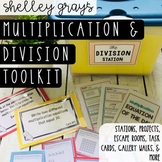Multiplication Task Cards BUNDLE for Basic Facts
- Zip
What educators are saying
Products in this Bundle (17)
showing 1-5 of 17 products
Also included in
- Struggling to figure out how to properly teach multiplication and division, and continue to incorporate them into your classroom throughout the year?The Multiplication and Division Tool Kit will make this much easier for you! This special bundle includes loads of resources for teaching and reinforciPrice $127.95Original Price $153.36Save $25.41
Description
If your goal is to get really strategic with multiplication instruction in your classroom this year, this resource is for you!
This Big Bundle of basic multiplication task cards includes SEVENTEEN sets of task cards to encourage independent, strategic learning and reinforcement in your classroom!
The following sets are included:
- Basic Multiplication Problem- Solving
- Basic Multiplication Flashcards for Facts 0-12
- Working with all Basic Multiplication Facts from 0-12
- Working with all Basic Multiplication Facts from 0-10
Each set includes 24 task cards that encourage conceptual learning through problem-solving, arrays, strategic thinking, finding missing numbers, skip-counting, picture representations, and more. Recording sheets and answer keys are also included.
**********************************************************************
If you are currently using The Multiplication Station in your classroom, these task cards are a fantastic supplement! Use them as extra practice after each level for the students who need it before their oral assessment.



